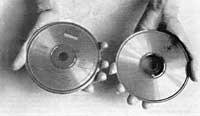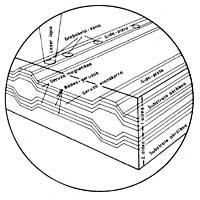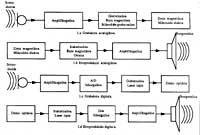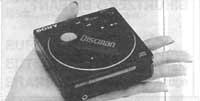Erasable optical disc
1986/12/01 Barandiaran, Xabier Iturria: Elhuyar aldizkaria
Although the video album did not have a very successful start, its future seems different. However, this time an important feature has been added to the quality of the playback system that is used on the video disk: the eliminability.
Therefore, this optical disc will not only serve to play, but also to record TV images or anywhere else. Without lips the erasable video disk will be directly concurrent with the magnetoscope immediately after its commercialization.
However, in the beginning, eraser optical disks, data and documents (texts, photographs, etc.) will only be useful for storing and on a second occasion will become supports to store the animated image.
It seems that erasable optical discs will have great importance in the electronic market in the coming years, as Xerox, RCA, Philips, Nippon Electric, TDK, Fuji, Sony and other companies are developing such products quickly.
The large storage capacity of the video disk and the erasability characteristics of the magnetic tape are added to the erasable optical disk. The materials used to obtain this sum have been combined Terbium/Iron (Tb Fe) or Gadolino/Terbium/Iron (Gd Tb Fe).
The material used in 1982 on a erasable disc developed by SONY was a composite of Terbio/Hierro/Cobalto (Tv Fe Co). In this 30 cm diameter disc can be digitally recorded 21x30 cm 40,000 physical or analog images 35 minutes of program.
It must be said that at the moment the animated images of the video are not recorded in digital, since the recorder that would handle the flow of information that would be necessary has not yet been fully developed. Therefore, video information, unlike sound information, can only be stored at the moment in an analog way.
The internal structure of the erasable disk is shown in Figure 1. In the section of the disc it is observed that it consists of a layer of Tv/Fe/Co sensitive to optical and magnetic effects, and each of its faces is covered by another layer of transparent protection. All this is immersed in an acrylic substrate, surface material of the disc. The sensitive layer and protective layers form embossed tracks that will guide the laser instead of launas. Each track has a width of 0.8 microns and the separation between both tracks is 0'8 microns.
The recording takes advantage of the magnetic property of the TV/Fe/Co. To increase the density of the accumulated information, magnetization is done by joining (and not horizontally as in conventional magnetic tape). The main property of this compound, when heated by laser effect and under the influence of a variable magnetic field, is to stop reversing the direction of magnetization. Therefore, the recording performed in the 500 Oersted area and under the influence of a 4 mW laser can be removed with an area of 1000 Oersted and a power of 5 mW reversing the direction of magnetization.

The optical/magnetic effect of Ker is used to read the recording. The polarized light of a laser beam is emitted to the disc track and reflected on the track with an angle that depends on the direction of magnetization of the material (+0'35º wing -0'35º).
Since the quality of the video disc is better than the magnetic tape, it is appreciated that the latter will lose its current prominence. However, it is not very likely that the magnetic tape will disappear completely.
Let's compare the characteristics of the optical disc with the magnetic tape. As for the storage capacity of digital information, the optical disc can store 40 million bits/cm 2 and the magnetic tape only 2 million.
Through the analog accumulation of animated video information (as mentioned above, only this type of information can be stored at the moment), the compact video disc (12 cm in diameter) can take a twenty minute program or a fixed color photograph (one per track) of good quality 16,000.
Given the durability of the accumulated information, the optical disc becomes much better than the magnetic tape. Disk recording is much more stable and the risks of accidental deletion are almost negligible. In addition, when using the laser there is no physical contact with the disc surface and recording and reading occurs without disc wear.
The possibilities of reuse in the disc are almost endless. SONY, MATUSHITA and 3M confirm that each disc can be deleted a million times without modifying its quality features.
Also in the search for information, the optical disc is more appropriate than the magnetic tape. On the disc, to find the chosen part, it is enough a few seconds. In the cassette, when passing the tape, it takes several tens of seconds.
The production of erasable optical discs will be carried out in three formats: 12 cm in diameter on compact discs and 20 cm and 30 cm in diameter on discs. It seems that with the optical disk will not happen what happened with video reading systems (three different systems to do the same as VHS,~ and V2000). The PHILIPS system for non-removable compact discs used in sound reproduction has been adopted worldwide as standard. Therefore, any compact disc you buy in the neighborhood store is suitable for any device of any brand. We expect the same to happen with erasable optical discs.
Due to large economic interests, research on the erasable disk is developing rapidly in recent times. In the coming years it is considered that this new product will be a commercial reality for both computer and video and audio. A French company, Verbatin (subsidiary of Kodak), has announced its intention to market the erasable thermomagnetic disc in early 1987. This disk will be used to store data and will have a capacity of 100 Megas. That is, the content of the 50,000 pages.
Thomson and Nakamichi have agreed to produce a similar album. thomson will develop the album and Nakamichi recorder-reader. The first prototypes will be ready by the end of 1986. The compact erasable audio disk will have a recording capacity of 5 hours and the same disk will accept the recording of a video and an audio program of one hour on each side.
In the future, erasable optical discs could be used to store all kinds of information. Therefore, with a single device we can record and read video, sound and data (software, still images, etc. ). But for this to happen, the road to normalization remains long.
Digital recording
Sound information can be stored in two ways, analog and digital. Analogically, at every moment, the signal can take any value from an interval. Therefore, theoretically, the number of possible values is infinite. Recording in this way adds noise (unwanted signal) to the signal to the amplifier and recorder.
When reading the information, the reader receives all the recorded signals, both the good signal and the noise. Then, partially changing the shape of the signal (distorting it), amplifies it and finally converts it into sound.
Digitally, at every moment the signal can only take two different values previously determined. To record the signal, it is first amplified and then converted digitally using an analog/digital converter.
This digital information is recorded by laser beams on an optical disc. This procedure adds noise to the signal. However, once the information is read by laser beams, the digital/analog converter is able to reconstruct the good signal, largely avoiding distortion and noise.
This is because the converter only has to choose between two specific values, and although the impulse is distorted and mixed with noise, it can differentiate whether it is one or zero and convert the information in an analog way once regenerated.
Therefore, in digital recording background noise and distortion are much lower than in analog.

Gai honi buruzko eduki gehiago
Elhuyarrek garatutako teknologia







